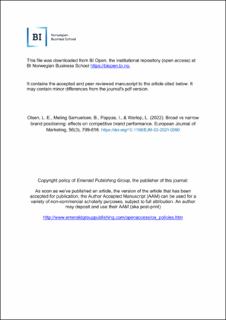| dc.contributor.author | Olsen, Lars Erling | |
| dc.contributor.author | Pappas, Ioannis | |
| dc.contributor.author | Samuelsen, Bendik Meling | |
| dc.contributor.author | Warlop, Luk | |
| dc.date.accessioned | 2023-09-25T07:48:17Z | |
| dc.date.available | 2023-09-25T07:48:17Z | |
| dc.date.created | 2022-01-18T14:58:52Z | |
| dc.date.issued | 2022 | |
| dc.identifier.issn | 0309-0566 | |
| dc.identifier.uri | https://hdl.handle.net/11250/3091623 | |
| dc.description.abstract | Purpose –Brand managers can choose among two fundamentally different brand positioning strategies. One is a broad brand strategy, focusing on many favorable brand associations. The other is a narrow brand strategy, focusing on just a few and thus more mentally accessible associations. Building on associative memory theory, the current article examines which of these brand positioning strategies performs better under dynamic market conditions. Design/methodology/approach – Three experiments test the effect of brand positioning strategy on memory accessibility and competitive brand performance. Study 1 tests how brand strategy (broad vs. narrow) affects defensive brand performance. Study 2 tests how broad vs. narrow brands perform differently in a brand extension scenario (offensive brand performance). Study 3 uses real brands and situation-based attributes as stimuli in a defensive scenario. Findings – The results show that a narrow brand positioning strategy leads to a competitive advantage. Narrow brands with fewer and more accessible associations resist new competitors more easily and have higher brand extension acceptance than do broad brands. Research implications – The article shows how to use accessibility as evidence of associative strength and test how accessibility influences competitive brand performance in a controlled experimental context. Practical implications – Brand managers would benefit from a narrow brand positioning strategy in accordance with the USP school of thought used by many marketing practitioners. Originality – The paper demonstrates that narrow brand positioning performs better than broad brand positioning in dynamic markets, and to our knowledge is the first to do so. | en_US |
| dc.language.iso | eng | en_US |
| dc.publisher | Emerald | en_US |
| dc.rights | Navngivelse-Ikkekommersiell 4.0 Internasjonal | * |
| dc.rights.uri | http://creativecommons.org/licenses/by-nc/4.0/deed.no | * |
| dc.subject | brand positioning | en_US |
| dc.subject | associative memory | en_US |
| dc.subject | competitive performance | en_US |
| dc.title | Broad vs. Narrow brand positioning: Effects on competitive brand performance | en_US |
| dc.type | Peer reviewed | en_US |
| dc.type | Journal article | en_US |
| dc.description.version | acceptedVersion | en_US |
| dc.rights.holder | Emerald | en_US |
| dc.source.volume | 56 | en_US |
| dc.source.journal | European Journal of Marketing | en_US |
| dc.source.issue | 3 | en_US |
| dc.identifier.cristin | 1983784 | |
| cristin.ispublished | false | |
| cristin.fulltext | postprint | |
| cristin.qualitycode | 1 | |

